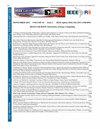Design and Comparative Analysis of THz Antenna through Machine Learning for 6G Connectivity
IF 1.3
4区 工程技术
Q3 COMPUTER SCIENCE, INFORMATION SYSTEMS
引用次数: 0
Abstract
The rise of sixth-generation (6G) technology has become increasingly necessary to meet the growing demand for high-speed internet and the continuous advancements in technology. The development of an optimal antenna design is crucial to attain the required performance and capabilities. Traditional electromagnetic modeling approaches for antenna design are, however, time-consuming and computationally intensive requiring long simulation time and high-end computing systems. Therefore, Machine Learning (ML) technology can be utilized to deal with these limitations in the context of Terahertz (THz) antenna design, which has not been done before. The main objective of this work is to develop an antenna that operates in the THz Band, which is the essential 6G band for the future infrastructure revolution, and to predict and optimize the antenna's return loss using ML models like K-Nearest Neighbour (KNN), Extreme Gradient Boosting (XG-Boost), Decision Tree, and Random Forest and Mean Squared Error (MSE) of 3.816. The findings show that all of these models perform accurately, particularly Random Forest having the highest accuracy of 82% in predicting the return loss. ML offers novel possibilities for the development of optimized and efficient 6G antennas for high-speed communication.通过机器学习设计和比较分析用于 6G 连接的太赫兹天线
为了满足人们对高速互联网日益增长的需求和技术的不断进步,第六代(6G)技术的兴起变得越来越有必要。要达到所需的性能和功能,开发最佳天线设计至关重要。然而,传统的天线设计电磁建模方法耗时且计算密集,需要较长的仿真时间和高端计算系统。因此,在太赫兹(THz)天线设计中,可以利用机器学习(ML)技术来解决这些限制,这在以前还没有过。这项工作的主要目标是开发一种工作在太赫兹频段(未来基础设施革命中必不可少的 6G 频段)的天线,并使用 K-Nearest Neighbour (KNN)、Extreme Gradient Boosting (XG-Boost)、Decision Tree 和 Random Forest 等 ML 模型预测和优化天线的回波损耗,平均平方误差 (MSE) 为 3.816。研究结果表明,所有这些模型都表现准确,尤其是随机森林预测回波损耗的准确率最高,达到 82%。ML 为开发优化、高效的 6G 高速通信天线提供了新的可能性。
本文章由计算机程序翻译,如有差异,请以英文原文为准。
求助全文
约1分钟内获得全文
求助全文
来源期刊

IEEE Latin America Transactions
COMPUTER SCIENCE, INFORMATION SYSTEMS-ENGINEERING, ELECTRICAL & ELECTRONIC
CiteScore
3.50
自引率
7.70%
发文量
192
审稿时长
3-8 weeks
期刊介绍:
IEEE Latin America Transactions (IEEE LATAM) is an interdisciplinary journal focused on the dissemination of original and quality research papers / review articles in Spanish and Portuguese of emerging topics in three main areas: Computing, Electric Energy and Electronics. Some of the sub-areas of the journal are, but not limited to: Automatic control, communications, instrumentation, artificial intelligence, power and industrial electronics, fault diagnosis and detection, transportation electrification, internet of things, electrical machines, circuits and systems, biomedicine and biomedical / haptic applications, secure communications, robotics, sensors and actuators, computer networks, smart grids, among others.
 求助内容:
求助内容: 应助结果提醒方式:
应助结果提醒方式:


